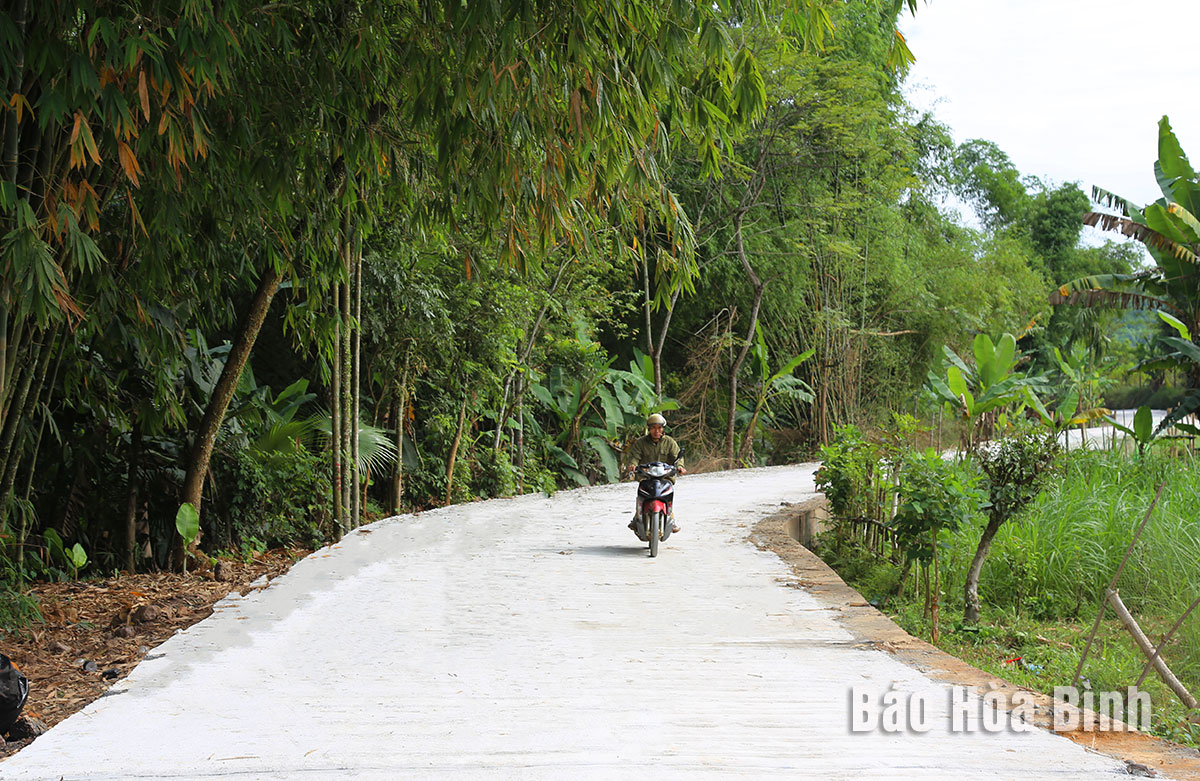
The northern province of Hoa Binh has undergone a remarkable transformation thanks to the successful implementation of the national target programme on building new-style rural areas. In recent years, localities across the province have adopted comprehensive strategies, with a particular focus on infrastructure investment, to drive rural development forward.
Thanks to the new-style rural development programme, more investment has been poured in transport infrastructure in rural areas.
Once a disadvantaged commune in Tan Lac district, Gia Mo embarked on its rural development journey from a low starting point. However, with strong support from the Party and State, along with the dedication of local authorities and residents, it has made significant strides. In 2021, Gia Mo was officially recognised as meeting new-style rural area standards, and improvements have continued since then.
Last year, Dung hamlet received funding to pave its internal roads, significantly enhancing its transportation network. Bui Van Trung, head of the hamlet, highlighted the programme’s impact, stating that roads have been gradually upgraded, making travel easier for residents. Notably, villagers voluntarily donated over 7,600 square meters of land and hundreds of trees to support the initiative.
Beyond transportation, community infrastructure has also seen significant upgrades. For example, in Gia Phu hamlet—formed from the merger of Bo and Quan hamlets—the once-deteriorating stilt house that served as a cultural center has been replaced with a modern facility.
"The new cultural house features a spacious courtyard with two volleyball courts, allowing residents to engage in sports and cultural activities with neighboring hamlets," said Bui Van Duong, a resident of Gia Phu.
According to the Tan Lac district People’s Committee, over 7.6 billion VND (approximately 297,660 USD) was mobilised for new rural development last year. By the end of 2024, 10 communes had fulfilled all the 19 criteria for new-style rural areas, while five others met between 10 and 14 criteria. This year, the district aims to add one more commune to the list of new-style rural areas and upgrade three others to advanced new-style rural status.
Across Hoa Binh province, efforts have been even more extensive. Last year, localities mobilised over 8.8 trillion VND for rural development, prioritising infrastructure improvements such as roads, irrigation systems, electricity, schools, healthcare centres, and cultural facilities. As a result, 96 out of 129 communes now meet transportation criteria and all communes have access to stable electricity for both production and daily life.
As many as 121 out of 129 communes meet irrigation and disaster prevention standards. Significant advancements have been made in education and healthcare infrastructure. By the end of 2024, Hoa Binh saw three new communes recognised as meeting new-style rural standards, four achieving advanced new-style rural status and two designated as model new-style rural areas, bringing the numbers of such communes to 83, 32 and three, respectively.
Looking ahead, Hoa Binh aims to certify nine more communes as new-style rural standards, upgrade three to model status, and have two districts recognised as new-style rural areas.
To achieve these ambitious goals, the province will continue prioritising investment in essential infrastructure, particularly in transportation, irrigation, electricity, and clean water. These efforts will ensure sustainable growth and improve the quality of life for local rural residents.
The Standing Board of the Hoa Binh provincial Party Committee has agreed in principle on a proposal by the Standing Board of the Party Committee of Hoa Binh city to gather feedback on the city’s 1:2000 zoning plan, which forms part of its broader urban development strategy.
Hoa Binh province has made notable progress in public administration reform and digital government development, with the satisfaction index among citizens and businesses reaching over 84%, according to recent government evaluations.
Thanks to great efforts by local authorities in recent times, the governance and public administration performance of Mai Chau district has been significantly improved.
In the afternoon of June 6, the Party Committee, the People's Council, the People's Committee and the Fatherland Front of Lac Son district solemnly held a meeting to celebrate the 139th anniversary of the district's founding (1886–2025) and the 79th anniversary of the establishment of the district's Party Committee (1946–2025). There was the attendance of Mr. Bui Van Thang, the Vice Chairman of the Provincial People's Council; Mr. Quach Tat Liem, the Vice Chairman of the Provincial People's Committee; Ms. Dang Bich Ngoc, the Deputy Head of the National Assembly Delegation of the province; as well as the former leaders of the province and district through various periods, who are the natives of the district.
Implementing the Politburo’s Resolution No. 57-NQ/TW on breakthroughs in science – technology, innovation, and digital transformation is a golden opportunity for the northern mountainous province of Hoa Binh to renew growth model, improve competitive edge and shorten digital gap.
Resolution 57-NQ/TW, issued by the Politburo on December 22, 2024, identifies sci-tech, innovation, and digital transformation as strategic breakthroughs to build a developed and prosperous nation. In Hoa Binh province, this spirit is not just a slogan, it’s being put into action through concrete initiatives that form a "new development triangle”: digital citizenship, digital economy, and digital administration.



